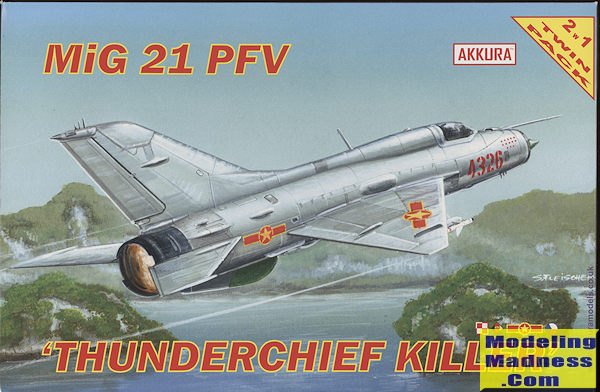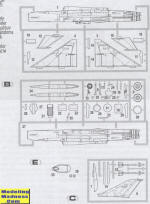
Akkura 1/72 MiG-21PFV 'Thunderchief Killer'
| KIT #: | A0006 |
| PRICE: | 9.99 Euros |
| DECALS: | Six options |
| REVIEWER: | Scott Van Aken |
| NOTES: |

| HISTORY |
The Mikoyan-Gurevich MiG-21 (Russian: Микоян и Гуревич МиГ-21) (NATO reporting name "Fishbed") is a supersonic jet fighter aircraft, designed and built by the Mikoyan-Gurevich Design Bureau in the Soviet Union. It was popularly nicknamed "balalaika", from the aircraft's planform-view resemblance to the Russian stringed musical instrument or ołówek (English: pencil) by Polish pilots due to the shape of its fuselage. Early versions are considered second-generation jet fighters, while later versions are considered to be third-generation jet fighters. Some 50 countries over four continents have flown the MiG-21, and it still serves many nations a half-century after its maiden flight. The fighter made aviation records. At least by name, it is the most produced supersonic jet aircraft in aviation history, the most produced combat aircraft since the Korean War, and it had the longest production run of a combat aircraft (1959 to 1985 over all variants).
Many consider the PF to be sort of a second generation of these aircraft. It kept many of the same features of the earlier F, but got a more powerful engine and eliminated the built in gun. This made it less useful to those who flew it. During the Egyptian's use of MiG-21s, most pilots preferred the older F over later versions just because of this gun and the plane's lighter weight. The Soviet built Atoll (a copy of the US Sidewinder) was generally considered to be a poor weapon and getting a hit with it was often as much chance as anything else. No wonder that the later MiG-21M series returned to having a gun, albeit one that was in a centerline pod.
| THE KIT |
 Akkura
is a kit maker from Poland and has mostly dealt with detail stuff. From what I
gather, this MiG-21 kit is originally an INNEX mold. It is short run as one can
tell from the thick sprue attachment points and somewhat large and soft engraved
detailing. This latter is subjective as it is really not that much more than
what you get on current Airfix kits. There is some flash and some of the parts
suffer from mold shift.
Akkura
is a kit maker from Poland and has mostly dealt with detail stuff. From what I
gather, this MiG-21 kit is originally an INNEX mold. It is short run as one can
tell from the thick sprue attachment points and somewhat large and soft engraved
detailing. This latter is subjective as it is really not that much more than
what you get on current Airfix kits. There is some flash and some of the parts
suffer from mold shift.  Instructions
are nicely done though they show some of the parts (such as the seat) to be a
lot more detailed than they actually are. Color information is provided in a
number of paint lines so you should have no issues in this regard.
Markings are for six planes from four different
countries. There are two Polish AF planes, one from the mid 1960s and the other
from the mid-1980s. Two North Vietnamese aircraft are also provided. These are
from the 921st Fighter Regiment and both, like the two polish aircraft, are in
unpainted metal. Also in unpainted metal is a Czech plane from the mid 1980s,
and rounding things out is the lone camouflaged version from the East German Air
Force, again from the mid 1980s. Decals have some issues in that some of the
markings are off register. The yellow in the Vietnamese insignia seems to be too
dark and this is probably due to bleed-through of the background red.
Fortunately, there is no lack of aftermarket for the MiG-21PF, though it would
have been nice if the kit markings had been perfect.
Instructions
are nicely done though they show some of the parts (such as the seat) to be a
lot more detailed than they actually are. Color information is provided in a
number of paint lines so you should have no issues in this regard.
Markings are for six planes from four different
countries. There are two Polish AF planes, one from the mid 1960s and the other
from the mid-1980s. Two North Vietnamese aircraft are also provided. These are
from the 921st Fighter Regiment and both, like the two polish aircraft, are in
unpainted metal. Also in unpainted metal is a Czech plane from the mid 1980s,
and rounding things out is the lone camouflaged version from the East German Air
Force, again from the mid 1980s. Decals have some issues in that some of the
markings are off register. The yellow in the Vietnamese insignia seems to be too
dark and this is probably due to bleed-through of the background red.
Fortunately, there is no lack of aftermarket for the MiG-21PF, though it would
have been nice if the kit markings had been perfect.
| CONCLUSIONS |
So what is the verdict on this one. Well, I would put it into the category of the KP MiG-21 in several areas as it seems quite similar. This one has superior surface detail, better molded part to some extent, and has the major benefit of offering two kits in one box. I mentioned that it could really benefit from a proper seat so that should be on every builder's list if they want to tackle this one. I don't anticipate any major issues and while the detail fiends may want to look elsewhere, for most of the rest of us, it is really quite a good deal if one simply wants a nice model to put on their shelves. Anyone with some 'time in the trenches' should be able to handle this one just fine.
| REFERENCES |
http://en.wikipedia.org/wiki/MiG-21
MiG-21 Walkaround, Part 1, Squadron/Signal, 2004
January 2017
Copyright ModelingMadness.com. All rights reserved
If you would like your product reviewed fairly and fairly quickly, please contact the editor or see other details in the Note to Contributors.
Back to the Main Page Back to the Review Index Page Back to the Previews Index Page